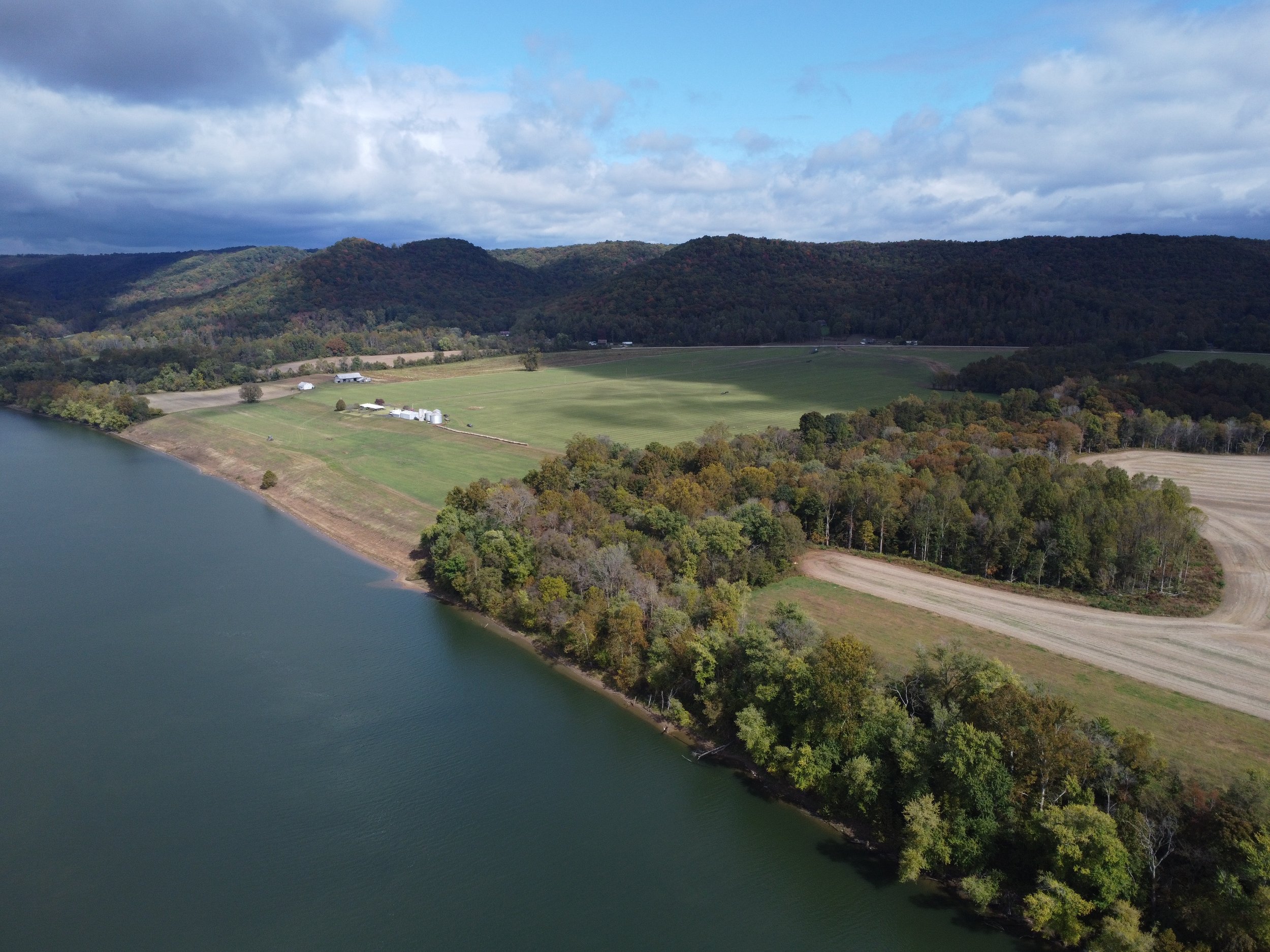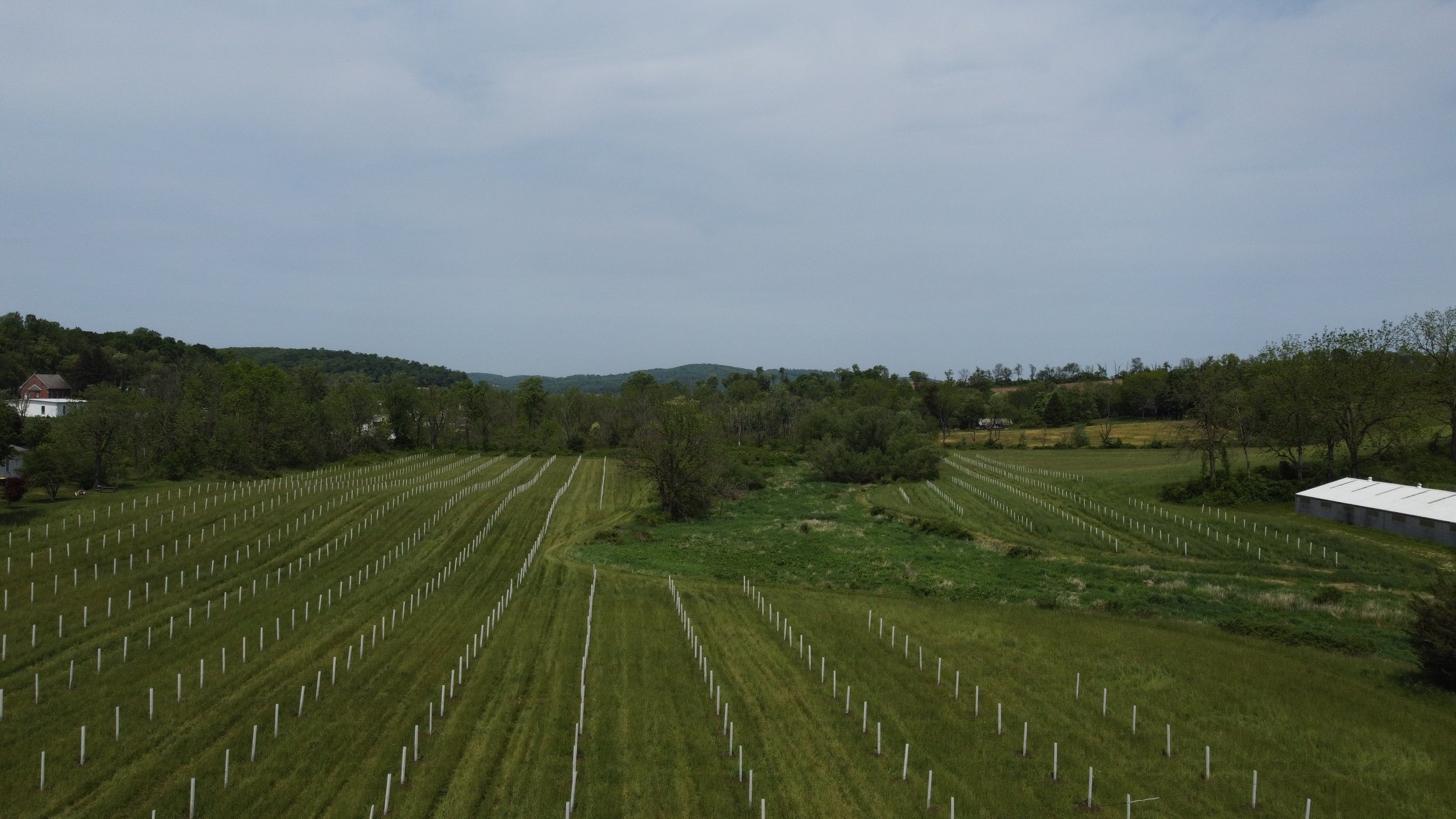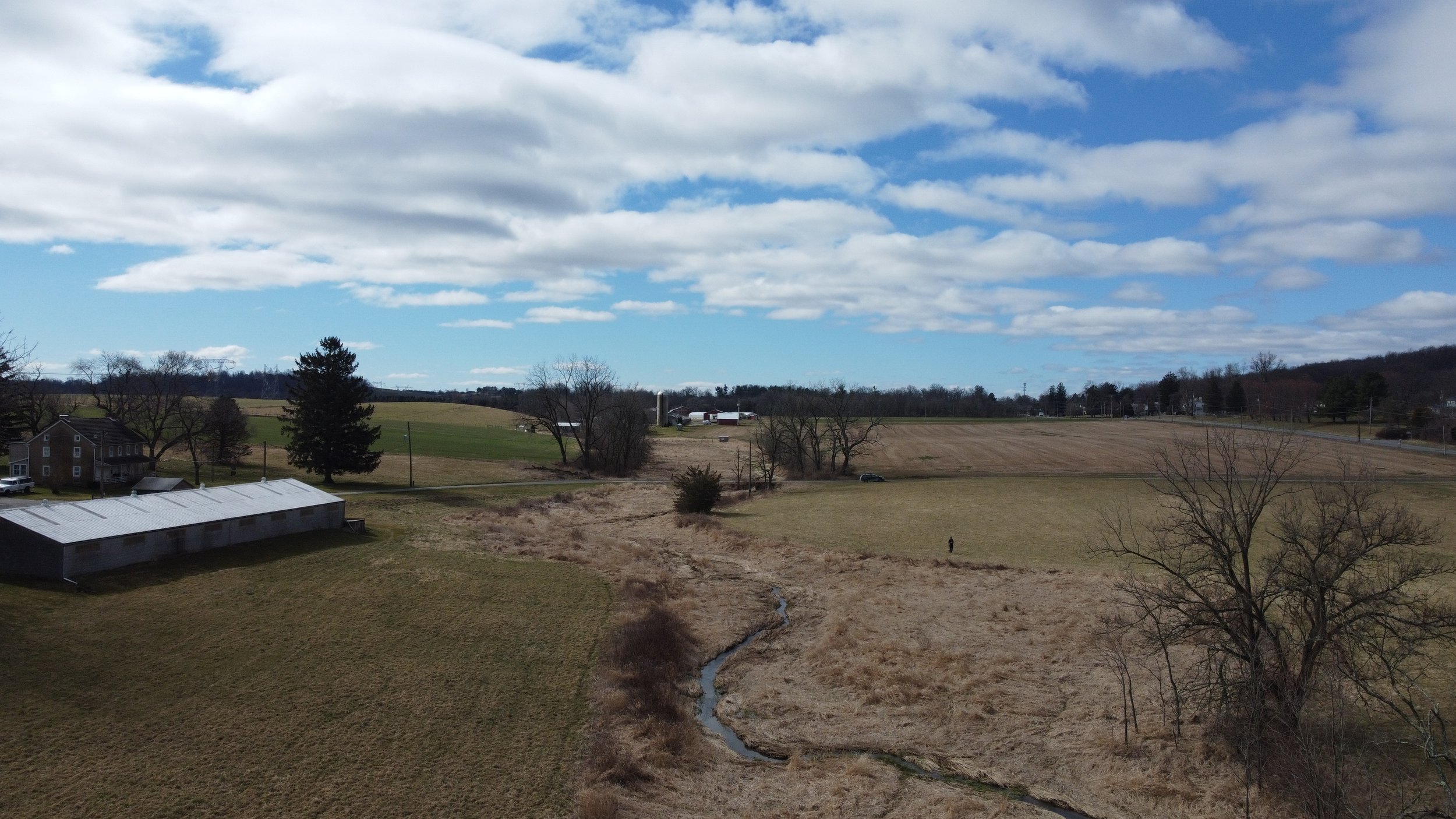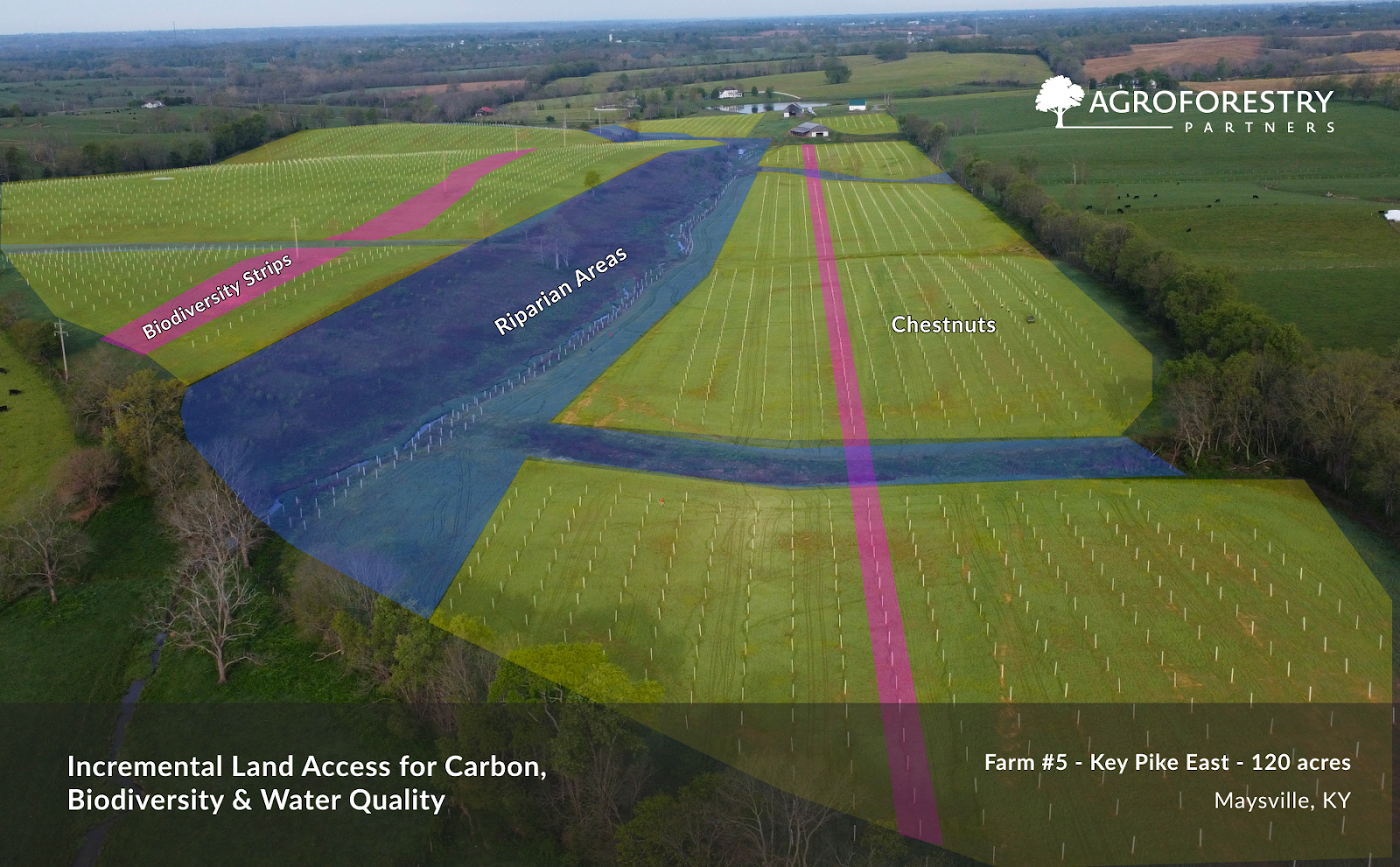Improving Water Quality with Agroforestry
The impacts of agricultural runoff on waterways are well-known. The solutions and their efficacy are less clear. Muddying the waters, farmers and landowners looking to improve water quality must navigate a complex regulatory and financing matrix, with liability and funding varying from state to state, county to county. Operators must weigh a host of regenerative options: cover crops, conservation tillage, nutrient management plans, no-till, buffer zones (the list goes on) — each with its own agronomic and economic considerations.
Trees can be the single most impactful tool at a farm’s disposal. When planted and managed well, trees can reduce operational risks associated with water pollution, reduce input costs, and provide alternative streams of income. Below, we’ll explore the hidden costs of inaction, the multi-faceted benefits trees bring to farms and waterways, and how to find funding to realize these benefits without bearing the costs alone.
How agriculture affects water quality
Agricultural pollution can be either “point source” – traceable to a single polluter, such as a manure lagoon or CAFO – or “nonpoint source,” whereby agrichemical make their way into waterways through runoff, leaching, and volatilization. Nonpoint souce pollution occurs at massive scales: An estimated 3.5 billion pounds of nutrient fertilizer enters the Gulf of Mexico annually, while an estimated 286 million pounds of nitrogen and 19.9 million pounds of phosphorus enter the Chesapeake Bay each year.
The impacts of nonpoint source pollution are far reaching. Nitrogen and phosphorus runoff drive eutrophication, causing hypoxia (deoxygenation of water) and eventual “dead zones,” i.e. “fish kills.” Dead zones in the Chesapeake Bay, Great Lakes, and Gulf of Mexico are among the most infamous examples, stretching across 32,000 sq miles. But beyond the US, a combination of pollution and climate change pose an existential threat to aquatic life writ large, with 90% of all marine life threatened with extinction by 2100. Agrichemicals in drinking water also pose a threat to public health, linked to cancer, brain damage, fertility problems, and hormone disruption. Unsurprisingly, 70% of Americans are concerned about the quality of their tap water.
Risk reductions and cost savings
Although nonpoint source agricultural runoff is exempt from the Clean Water Act, in some places, lawsuits have been leveled against agricultural communities over pollution-wrought damage to public watersheds, with cleanup costs exceeding $2 billion annually. Similarly, nuisance suits against CAFOS (or concentrated animal feeding operations) for point-source pollution are on the rise, suggesting mounting public opinion favoring stricter environmental protections. Asset managers, farmers and agribusiness should respond accordingly, shifting production practices to reduce not only their downstream impact, but also liability and risk.
Ultimately, practices that reduce nutrient runoff benefit a farm’s bottom line, keeping nutrients in the soil where plants can use them. Given that the cost of fertilizer rose exponentially during the pandemic – continuing to rise even post-pandemic – many farmers have shifted their operations in small ways, opting to grow soy, a nitrogen fixing crop, over corn. But these temporary solutions do not resolve the larger issue: the amount of fertilizer lost in conventional systems is still too high.
Fertilizer Use Efficiency refers to the rate at which fertilizers are used by a cropping system. Importantly, Nitrogen Use Efficiency (NUE) and Phosphorus Use Efficiency (PUE) can determine not only yields, but also the amount of nutrient runoff entering waterways. On average, NUE and PUE globally stand at 30% and 16%, with the remainder is lost to leaching, runoff, and volatilization. All told, this can result in billions of dollars in fertilizer wasted. Although a number of environmental, spatiotemporal and genetic factors impact the FUE of soil-crop systems, regenerative practices such as agroforestry have been shown to reduce fertilizer losses, cycling these nutrients back into the soil.
Why trees are critical to protect water quality
The impact of a given practice on water quality can vary wildly from place to place, soil to soil, and farmer to farmer, resulting in conflicting notions about the efficacy of certain practices. For example, while no-till is generally assumed to be less impactful than conventional tillage, studies suggest that runoff and leaching are similar in these systems. The efficacy of cover cropping can be similarly variable depending on factors like establishment, soil temperature, and species selection.
Because of the inherent complexities of crop-soil systems, experts agree that stacking regenerative practices is the best way to minimize agricultural pollution. In general, annual agriculture leads to more runoff and erosion than perennial systems, though agroforestry – the intentional combining of annuals and perennials – can improve water quality better than annuals alone, while also de-risking a portfolio through revenue diversification.
Agroforestry improves water quality through:
Soil Structure: Trees contribute organic matter (OM) to the soil through root biomass and above-ground residues. Reduced disturbance enables the buildup of OM, enhancing soil structure, water infiltration, and water-holding capacity.
Erosion control: Trees roots stabilize soil, while leaf canopies slow rainfall, reducing erosion caused by water runoff. This is especially important in hilly or sloping areas where erosion can lead to sedimentation.
Nutrient management, filtration and buffering: Trees support nutrient cycling by trapping and storing nutrients in organic forms. Additionally, trees along waterways act as a natural filter trapping sediment, pollutants, and nutrients.
Shade and temperature: By shading waterways, trees regulate temperature. Cooler water temperatures support healthier aquatic ecosystems.
Soil biodiversity: Trees support beneficial soil organisms such as earthworms and soil microbes that enable nutrient cycling, pest control, and soil health maintenance.
Matching species to suitability and farmer goals
Watershed solutions can be economically viable, with studies finding $1.75 returned for every $1 invested.
Tree-based systems, in particular, return a greater excess over capital invested (e.g. compared to waste management systems or cover crops), given that they serve as revenue-generating enterprises in addition to providing ecological services. That said, selecting species for working buffers can be challenging, as different topographies, soil types, and farmer goals necessitate custom system design.
Examples of Propagate-planted working buffers include:
Commercial buffers: In the low-land, elderberry and American hazelnut – two species that tolerate wet feet – planted at commercially viable scales. On slopes, moneymakers like chestnut provide erosion control and revenue diversification.
Silvopasture: Native species mixtures selected for calorie and shade provision, alongside willow and mulberry fodder, increase animal welfare, weight gain and milk production for graziers.
Alley cropping: Fast-timber species grown alongside commodity grains. Our farmer partner planted black locust and barley.
Traditional forest buffers: A mixture of native riparian species, directly abutting stream banks and waterways.
Overyield, an agroforestry analytics tool, can be used to design and model the economics of these systems.
Scaling watershed solutions
Despite their benefits, many farmers have been hesitant to transition large acreage from annual agriculture to perennial systems – or to implement conservation practices more generally – due to the costs, risks, and uncertainty associated with adopting new practices.
Barriers include upfront costs like seed or nursery stock, knowledge gaps, and offtake concerns, though additional complexities arise due to land tenure and non-operating ownership.
That said, a handful of public and private financing options exist to resolve the capital hurdle associated with regenerative transition.
Innovative financing vehicles like Agroforestry Partners enable large-scale tree planting
USDA programs (e.g. EQIP, CRP, Climate Smart Commodities) provide full cost-shares and incentive payments for different practices
State and local incentives (cost-shares programs, grants, and tax incentives)
Of course, navigating these options can be difficult.
Propagate works with farmers, landowners, investment managers, agribusinesses, and other partners to overcome hurdles by developing custom solutions targeting specific economic and ecological goals.
For example: Propagate worked alongside Stroud, farmers, government agencies and a handful of other partners to pilot working buffers in Eastern PA, unlocking financing opportunities that helped plant over 20,000 trees on 60+ acres.
Interested in improving water quality through regenerative agriculture?
Contact us to see how we can help.







